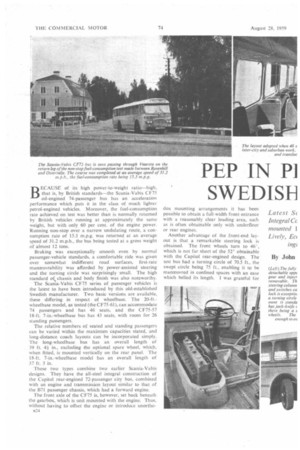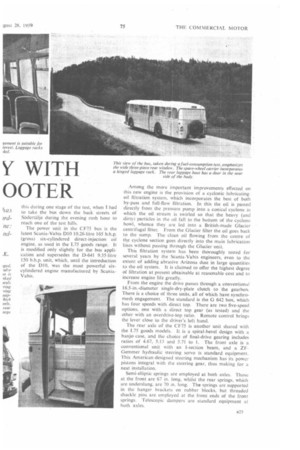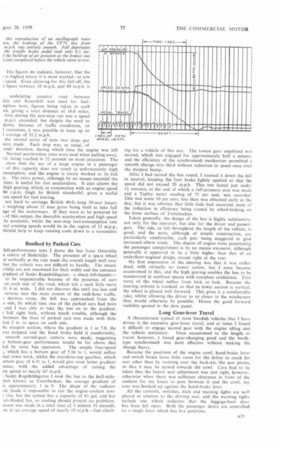PEP TN 11 SWEDISH
Page 58

Page 59

Page 60

Page 63

If you've noticed an error in this article please click here to report it so we can fix it.
By John
.E.
BECAUSE of its high power-to-weight ratio—high, that is, by British standards—the Scania-Vabis CF75 oil-engined 74-passenger bus has an acceleration performance which puts it in the class of much lighter petrol-engined vehicles Moreover, the fuel-consumption rate achieved on test was better than is normally returned by British vehicles running at approximately the same weight, but with only 60 per cent. of the engine power. Running non-stop over a narrow undulating route, a consumption rate of 15.3 m.p.g. was returned at an average speed of 31.2 m.p.h., the bus being tested at a gross weight of almost 12 tons.
Braking was exceptionally smooth even by normal passenger-vehicle standards, a comfortable ride was given over somewhat indifferent road surfaces, first-rate manceuvrability was afforded by power-assisted steering and the turning circle was surprisingly small. The high standard of .chassis and body finish was also noteworthy. The Scania-Vabis CF75 series of passenger vehicles is the latest to have been introduced by this old-established Swedish manufacturer. Two basic versions are available, these differing in respect of wheelbase. The 20-ft.wheelbase model, as tested (the CF75-61), can accommodate 74 passengers and has 46 seats, and the CF75-57 18-ft. 7-in.-wheelbase bus has 43 seats, with room for 26 standing passengers.
The relative numbers of seated and standing passengers can be varied within the maximum capacities stated, and long-distance coach layouts can be incorporated simply. The long-wheelbase bus has an overall length of 39 ft. 41 in., excluding the optional spare wheel, which, when fitted, is mounted vertically on the rear panel. The 18-ft, 7-in.-wheelbase model has an overall length of 37 ft. 3 in.
These two types combine two earlier Scania-Vabis designs. They have the all-steel integral construction of the Capitol rear-engined 72-passenger city bus, combined with an engine and transmission layout similar to that of the 1371 passenger chassis, which had a forward engine.
The front axle of the CF75 is, however, set back beneath the gearbox, which is unit mounted with the engine. Thus, without having to offset the engine or introduce unortho 1324 dox mounting arrangements it has been possible to obtain a full-width front entrance with a reasonably clear loading area, such as is often obtainable only with underfloor or rear engines.
Another advantage of the front-end layout is that a remarkable steering lock is obtained. The front wheels turn to 46', which is not far short of the 52 obtainable with the Capitol rear-engined design. The test bus had a turning circle of 70.5 ft., the swept circle being 75 ft., enabling it to be manceuvred in confined spaces with an ease which belied its length. I was grateful for this during one stage of the test, when I had to take the bus down the back streets of Sodcrtalje during the evening rush hour to reach one of the test hills.
The power unit in the CF75 bus is the latest Scania-Vabis D10 10.26-litre 165 b.h.p. (gross) six-cylindered direct-injection oil engine, as used in the L75 goods range. It is modified only slightly for the bus application and supersedes the D-64I 9.35-litre 150 b.h.p. unit, which, until the introduction of the DIO, was the most powerful sixcylindered engine manufactured by ScaniaVabis. Among the more important improvements effected on this new engine is the provision of a cyclonic lubricatingoil filtration system, which incorporates the best of both by-pass and full-flow filtration, In this the oil is passed directly from the pressure pump into a conical cyclone in which the oil stream is swirled so that the heavy (and dirty) particles in the oil fall to the bottom of the cyclone bowl, whence they are led into a British-made Glacier centrifugal filter. From the Glacier filter the oil goes back to the sump. The clean oil flowing from the centre of the cyclone section goes directly into the main lubrication lines without passing through the Glacier unit.
This filtration system has been thoroughly tested for several years by the Scania-Vabis engineers, even to the extent of adding abrasive Arizona dust in large quantities to the oil system. It is claimed to offer the highest degree of filtration at present obtainable at reasonable cost and to increase engine life greatly.
From the engine the drive passes through a conventional 16.5-in.-diameter single-dry-plate clutch to •the gearbox. There is a choice of three units, all of which have synchromesh engagement The standard is the G 642 box, which has four speeds with direct top. There are two five-speed options, one with a direct top gear (as tested) and the other with an overdrive-top ratio. Remote control brings the lever close to the driver's left hand.
The rear axle of the CF75 is another unit shared with the L75 goods models. It is a spiral-bevel design with a banjo case, and the choice of final-drive gearing includes ratios of 4.67, 5.13 and 5.71 to I. The front axle is a conventional unit with an 1-section beam, and a ZFGemmer hydraulic steering servo is standard equipment. This American-designed steering mechanism has its power pistons integral with the steering gear, thus making for a neat installation.
Semi-elliptic springs are employed at both axles. Those at the front are 67 in. long, whilst the rear springs, which are underslung, are 70 in. long. The springs are supported in the hanger brackets on rubber blocks, but threaded shackle pins are employed at the front ends of the front springs. Telescopic dampers are standard equipment at both axles.
Bcndix-Westinghouse air-pressure braking equipment is employed to actuate the Scania-Vabis S-cam brakes. Power is supplied by a water-cooled twin-cylindered compressor, with an output of 18 c.f.m. at 2,200 engine r.p.m. An unusual braking feature is the incorporation of an air-pressure servo in the linkage of the single-pull hand brake. Another departure from previous Scania-Vabis practice is the abolition of a transmission drum for the hand brake, the linkage now being connected through a balance beam to the rear brakes.
An all-steel welded sub-frame forms the basis of this integral design, having two full-length longitudinal runners and eight cross-members incorporating outriggers. Steel pressings are employed also for the body framing and are welded directly to the underframe. Most of the outer body panels are of aluminium, although some of the rear-most ones are of steel, and all are riveted to the body structure. Steel inner panelling is oncealed behind decorative plastic laminates below waistrail level.
Plastics mouldings are employed for certain exterior panels, including the front and rear roof domes, the windscreen framing, the luggage-boot door, and the front and rear light nacelles.
The basic body shell has two jack-knife doors—an entrance ahead of the front wheels and an exit a little in front of the rear wheels. Both doors are actuated by air pressure. Three Beclawat Zephyr sliding windows are incorporated in the left side of the body, and there are two Weathershields glazed roof ventilators.
The kerb weight of the bus was 8+ tons, including fuel test tanks, and the load consisted of iron weights totalling 3 tons 7 cwt. I was told that by Swedish standards this represented 46 passengers and hand baggage. but by normally 1326 accepted British ratings it was equivalent to about 54 passengers. With myself and four Scania-Vabis representatives the gross running weight was 11 tons 19 cwt., of which 5 tons 7 cwt, was carried by the front wheels.
A stretch of private road running through the centre of the Scania-Vabis factory was used for the brake tests. An oscillograph, connected to a fifth wheel, had been provided for these tests and all the readings were consistent. When braking from both the test speeds some wheel-locking was noted, large quantities of rubber being deposited on the road.
Nevertheless, the oscillograph traces indicated clean braking characteristics, retardation starting within 0.2 second of
initial application of the pedal. Hand-brake figures were taken from 20 m.p.h. and an average of :14 per cent. (10.6 ft. per sec. per sec.) was obtained. These are good results for a single-pull brake on a vehicle weighing nearly 12 tons, particularly as little effort was required, although the servo tended to increase the lever travel somewhat.
Extremely good acceleration figures were obtained, and for the standing-start tests second gear was used to pull away, 40 m.p.h. being reached in fourth gear. The maximum speed in top gear is just over 55 m.p.h.. which is some 18 m.p.h. higher than is legally permitted in Sweden except on motorways, where 50 m.p.h. is allowed.
I was particularly pleased by the smoothness of the engine and transmission during the direct-drive acceleration tests between 10 m.p.h. and 40 m.p.h. Acceleration from 10-20 m.p.h. and 20-30 m.p.h, was reasonably constant, but fell off in rate between 30 m.p.h. and 40 m.p.h., the torque dropping by some 70 lb.-ft. over this speed range in direct
this reproduction of an oscillograph trace ows, the braking of the CF75 bus from m.p.h. was entirely smooth. Full depression the treadle brake pedal took only 0.1 sec. 1 the build-up of air pressure at the brakes was Y just completed before the vehicle came to rest.
The figures do indicate, however, that the : is highest where it is most wanted—at low speed. Even allowing for this fall-off, the 1 figure between 10 m.p.h. and 40 m.p.h. is undulating country road between Nile and Rosenhill was used for fuelnption tests. figures being taken in each on, giving a total distance of 16.6 miles. time during the non-stop run was a speed m.p.h. exceeded, but despite the need to down, because of traffic conditions, on 1 occasions, it was possible to keep up an 1 average of 31.2 m.p.h.
the second series of "tests two stops per were made. Each stop was, as usual, of onds' duration, during which time the engine was left Normal acceleration rates were used when pulling away, being reached in 22 seconds on most occasions. The show that the use of a large engine in a passenger of this capacity does not result in unfortunately high )nsumption, and the engine is rarely worked to its full ty. The extra power, although by no means essential the time, is useful for fast acceleration. It also allows the high gearing, which, in conjunction with an engine speed 00 r.p.m. (high by British standards), gives a useful um speed for fast touring.
not hard to envisage British 40-ft.-long 50-seat luxury s weighing about 12 tons gross being built to take full age of the motorways. If they were to be powered by ; of this output, the desirable acceleration and high speed be available, whilst the non-stop fuel-consumption rate nal cruising speeds would be in the region of 15 m.p.g., should help to keep running costs down to a reasonable
WHECL.,15.7Ft
Baulked by Parked Cars
hill-performance tests I drove the bus from Ostertalje
e centre of Sodertalje. The presence of a spare wheel al vertically at the rear made the overall length well over but the vehicle was not difficult to handle. The streets :rtalje are not renowned for their width and the entrance gradient of Sankt Ragnhildsgatan a sharp left-hander— to be impenetrable because of the presence of cars on each side of the road, which left a neck little more ft. 6 in. wide. I did not discover this until too Late and reverse into the main stream of the rush-hour traffic. devious route, the hill was approached from the e side, by which time one of the parked cars had been and I was able to take the bus on to the gradient, I full right lock, without much trouble, although the between the lines of parked cars was made with little han 2 in. to spare on each side.
he steepest section. where the gradient is I in 5.8, the yas stopped and the hand brake held it comfortably. smooth second-gear restarts were made, suggesting
e bottom-gear performance would be far above that
led by most bus operators. The simple four-speed which has a bottom gear of 5.16 to 1, would suffice mal town work, whilst the overdrive-top gearbox, which ottom gear of 6.31 to 1, would give even better gradient lance, with the added advantage of raising the tm speed to nearly 65 m.p.h.
L Sankt Ragnhildsgatan I took the bus to the half-mileimb known as Tvetabacken. the average gradient of is approximately 1 in 9. The shape of the radiator :ck made it impossible to test the engine-coolant tern: rise, but the system has a capacity of 8+ gal. and has six-bladed fan, so cooling should present no problems. tseent was made in a total time of 1 minute 34 seconds, :nt to an average speed of nearly 19 m.p.h.—fast climb ing for a vehicle of this size. The lowest gear employed was second, which was engaged for approximately half a minute. and the efficiency of the synchromesh mechanism permitted a smooth change into third without reduction in speed once over the steepest hump.
After I had turned the bus round, I coasted it down the hill in neutral, keeping the foot brake lightly applied so that the speed did not exceed 20 m.p.h. This test lasted just under If minutes, at the end of which a full-pressure stop was made and a Tapley meter reading of 75 per cent, was recorded. This was some 10 per cent, less than was obtained early in the day, but it was obvious that little fade had occurred, most of the reduction in efficiency being caused by wheel-locking on the loose surface of Tvetabacken.
Taken generally, the design of the bus is highly satisfactory, not only for the operator, but also for the driver and passengers. The ride, as felt throughout the length of the vehicle, is good, and the seats, although of simple construction, are particularly comfortable, each pair being staggered to give increased elbow room. The degree of engine noise penetrating the passenger compartment is by no means excessive, although generally it appeared to be a little higher than that of an underfloor-engined design, except right at the rear.
My first impression of the steering was that it was rather dead, with virtually no castor action, but I soon became accustomed to this, and the high gearing enables the bus to be manceuvred in confined spaces with complete confidence. Five turns of the wheel suffice from lock to lock. Because the steering column is cranked, so that its lower section is vertical, the wheel is placed well forward. This gives it a comfortable rake, whilst allowing the driver to sit closer to the windscreen than would otherwise be possible. Hence the good forward visibility quoted in the data panel.
Long Gear-lever Travel
A characteristic typical of most Swedish vehicles that I have driven is the excessive gear-lever travel, and at times I found it difficult to engage second gear with the engine idling and
the vehicle stationary. Once accustomed to the length of travel, however, I found gear-changing good. and the baulktype synchromesh was most effective without making the change heavy.
Because the positions of the engine cowl, hand-brake lever and switch boxes leave little room for the driver to reach his seat other than by vaulting over the backrest, the seat pivots, so that it may be turned towards the cowl. Care had to be taken that the lateral seat adjustment was just right, however. otherwise when there was sufficient clearance in front of the cushion for my knees to pass between it and the cowl, my coat was hooked up against the hand-brake lever.
All the controls, switches, dials and warning lights are well placed in relation to the driving seat, and the warning lights include one which indicates that the luggage-boot door has been left open. Both the passenger doors are controlled by a single lever which has five positions.




















































































































